Stability Analysis of Borehole Walls When Drilling with Normal-Temperature Drilling Fluids in Permafrost Strata
Abstract
:1. Introduction
2. The Mathematical Model for Stability of Borehole Walls in Permafrost Strata
2.1. Heat Transfer Equation of Permafrost Strata
2.2. Deformation Equation
2.3. Equations for Physical Properties of Strata
2.4. The Mechanical Model for Permafrost Sediments
3. Establishment and Analysis of the Mechanical Model for Stability of Borehole Walls in Permafrost Strata
3.1. The Mechanical Model for Stability of Borehole Walls in Permafrost Strata
3.2. Mechanical Responses of Strata around Boreholes during Drilling in Permafrost
4. Borehole Expansion Rates under Different Conditions
5. Conclusions
Author Contributions
Funding
Data Availability Statement
Conflicts of Interest
References
- Liao, Q.; Wang, B.; Chen, X.; Tan, P. Reservoir stimulation for unconventional oil and gas resources: Recent advances and future perspectives. Adv. Geo-Energy Res. 2024, 13, 7–9. [Google Scholar] [CrossRef]
- Zhang, L.; Pan, L.; Zou, Y.; Wang, J.; Li, M.; Feng, W. Recent Advances in Reservoir Stimulation and Enhanced Oil Recovery Technology in Unconventional Reservoirs. Processes 2024, 12, 234. [Google Scholar] [CrossRef]
- Zhang, J.; Tong, Z.; Niu, J. Exploration and exploitation progress of unconventional oil and gas in China. Adv. Resour. Res. 2021, 1, 13–19. [Google Scholar]
- Tang, Y.; Zhao, P.; Li, X.; Fang, X.; Yang, P. Numerical Simulation and Experimental Test of the Sliding Core Dynamics of a Pressure Controlled Jet Crushing Tool for Natural Gas Hydrate Exploitation. Processes 2022, 10, 1033. [Google Scholar] [CrossRef]
- Yuan, S.; Lei, Z.; Li, J.; Yao, Z.; Li, B.; Wang, R.; Liu, Y.; Wang, Q. Key theoretical and technical issues and countermeasures for effective development of Gulong shale oil, Daqing Oilfield, NE China. Pet. Explor. Dev. 2023, 50, 638–650. [Google Scholar] [CrossRef]
- Bird, K.-J.; Charpentier, R.-R.; Gautier, D.-L.; Houseknecht, D.-W.; Klett, T.-R.; Pitman, J.-K.; Moore, T.-E.; Schenk, C.-J.; Tennyson, M.-E.; Wandrey, C.-R. Circum-Arctic Resource Appraisal: Estimates of Undiscovered Oil and Gas North of the Arctic Circle; Fact Sheet; U.S. Geological Survey: Reston, VA, USA, 2008. [CrossRef]
- He, R.; Jin, H. Permafrost and cold-region environmental problems of the oil product pipeline from Golmud to Lhasa on the Qinghai–Tibet Plateau and their mitigation. Cold Reg. Sci. Technol. 2010, 64, 279–288. [Google Scholar] [CrossRef]
- Amberg, S.; Littke, R.; Lutz, R.; Klitzke, P.; Sachse, V. Influence of pleistocene glaciation on petroleum systems and gas hydrate stability in the olga basin region, barents sea. J. Pet. Geol. 2024, 47, 191–242. [Google Scholar] [CrossRef]
- Vernikovsky, V.-A.; Dobretsov, N.-L.; Metelkin, D.-V.; Matushkin, N.Y.; Koulakov, I.-Y. Concerning tectonics and the tectonic evolution of the Arctic. Russ. Geol. Geophys. 2013, 54, 838–858. [Google Scholar] [CrossRef]
- Sekretov, S.-B. Northwestern margin of the East Siberian Sea, Russian Arctic: Seismic stratigraphy, structure of the sedimentary cover and some remarks on the tectonic history. Tectonophysics 2001, 339, 353–371. [Google Scholar] [CrossRef]
- Wu, Q.; Liu, Y.; Zhang, J.; Tong, C. A review of recent frozen soil engineering in permafrost regions along Qinghai-Tibet Highway, China. Permafr. Periglac. Process. 2002, 13, 199–205. [Google Scholar]
- Li, Y.; Cheng, Y.; Yan, C.; Yang, H.; Gao, Q.; Han, S. Study on the Wellbore Shrinkage during Drilling Operation in Frozen Soil. In Proceedings of the 56th US Rock Mechanics/Geomechanics Symposium, Santa Fe, NM, USA, 26–29 June 2022. [Google Scholar]
- Li, Q.; Liu, J.; Wang, S.; Guo, Y.; Han, X.; Li, Q.; Cheng, Y.; Dong, Z.; Li, X.; Zhang, X. Numerical insights into factors affecting collapse behavior of horizontal wellbore in clayey silt hydrate-bearing sediments and the accompanying control strategy. Ocean Eng. 2024, 297, 117029. [Google Scholar] [CrossRef]
- Li, K.; Yin, Z. State of the Art of Coupled Thermo–hydro-Mechanical–Chemical Modelling for Frozen Soils. In Archives of Computational Methods in Engineering; Springer: Berlin/Heidelberg, Germany, 2024; pp. 1–58. [Google Scholar]
- Jia, H.; Wang, T.; Chen, W.; Ding, S.; Luo, T.; Sun, Q. Microscopic mechanisms of microwave irradiation thawing frozen soil and potential application in excavation of frozen ground. Cold Reg. Sci. Technol. 2021, 184, 103248. [Google Scholar] [CrossRef]
- Wu, Z.; Xu, L.; Wang, H.; Li, B.; Ke, K.; Sun, Y. Numerical simulation of insulated drilling technique with refrigerant fluid in the Arctic region. Appl. Therm. Eng. 2024, 253, 123788. [Google Scholar] [CrossRef]
- Yakoby, A.; Hatzor, Y.-H.; Pinkert, S. Enhanced borehole stability analysis for geological waste disposal under conditions of in-situ stress uncertainty: The case of Yamin Plain, Israel. Eng. Geol. 2023, 321, 107137. [Google Scholar] [CrossRef]
- Gao, X.; Wang, M.; Shi, X.; Li, X.; Zhang, M. Risk Assessment Method for Analyzing Borehole Instability Considering Formation Heterogeneity. Processes 2023, 12, 70. [Google Scholar] [CrossRef]
- Feng, S.; Chen, J.; Jones, S.-B.; Flerchinger, G.; Dyck, M.; Filipovic, V.; Hu, Y.; Si, B.; Lv, J.; Wu, Q.; et al. Miscellaneous methods for determination of unfrozen water content in frozen soils. J. Hydrol. 2024, 631, 130802. [Google Scholar] [CrossRef]
- Li, Y.; Cheng, Y.; Yan, C.; Song, L.; Zhou, X.; Niu, C. Influence of drilling fluid temperature on borehole shrinkage during drilling operation in cold regions. J. Pet. Sci. Eng. 2020, 190, 107050. [Google Scholar] [CrossRef]
- Kostina, A.; Zhelnin, M.; Plekhov, O.; Levin, L. Numerical simulation of stress-strain state in frozen wall during thawing. Procedia Struct. Integr. 2021, 32, 101–108. [Google Scholar] [CrossRef]
- Li, L.; Yang, J.; Ke, K.; Li, L.; Dong, M.; Zhu, G.; Cui, T. Research on the Influence Factors of Wellhead Thaw-Settlement in Polar Drilling. In Proceedings of the ISOPE International Ocean and Polar Engineering Conference, Rhodes, Greece, 16–21 June 2024. [Google Scholar]
- Zhou, X.; Su, Y.; Cheng, Y.; Li, Q. Evaluation of Thermal Insulation of Vacuum-Insulated Casing to Prevent Uncontrollable Melting of Ice and Borehole Instability in Permafrost. Processes 2024, 12, 1389. [Google Scholar] [CrossRef]
- Sun, J.; Wang, Z.; Liu, J.; Lyu, K.; Huang, X.; Zhang, X.; Huang, N. Research progress and development direction of low-temperature drilling fluid for Antarctic region. Pet. Explor. Dev. 2022, 49, 1161–1168. [Google Scholar] [CrossRef]
- Zhao, X.; Qiu, Z.; Huang, W.; Wang, M. Mechanism and method for controlling low-temperature rheology of water-based drilling fluids in deepwater drilling. J. Pet. Sci. Eng. 2017, 154, 405–416. [Google Scholar] [CrossRef]
- Jiang, G.; Ning, F.; Zhang, L.; Tu, Y. Effect of agents on hydrate formation and low-temperature rheology of polyalcohol drilling fluid. J. Earth Sci. 2011, 22, 652–657. [Google Scholar] [CrossRef]
- Shi, L.; Chen, S.; Li, M. Research on the characteristic parameters of Harbin seasonal frozen soils. Chin. J. Rock Mech. Eng. 2019, 38, 1053–1063. [Google Scholar]
- Li, Y.; Cheng, Y.; Yan, C.; Xue, M.; Niu, C.; Gao, Y.; Wang, T. Simulating the effect of frozen soil thaw on wellhead stability during oil and gas drilling operations in arctic waters. J. Cold Reg. Eng. 2020, 34, 04020026. [Google Scholar] [CrossRef]
- Wang, Z.; Wang, X.; Sun, B.; Deng, X.; Zhao, Y.; Gao, Y.; Li, H. Analysis on wellhead stability during drilling operation in arctic permafrost region. In Proceedings of the International Conference on Offshore Mechanics and Arctic Engineering, Trondheim, Norway, 25–30 June 2017; Volume 57762, p. V008T11A008. [Google Scholar]
- Christopher, H.; Serkan, I.; David, J.; Lee, Z. Heat generation during bone drilling: A comparison between industrial and orthopaedic drill bits. J. Orthop. Trauma 2017, 31, e55–e59. [Google Scholar]
- Wang, Y.; Liu, Y.; Cui, Y.; Guo, W.; Lv, J. Numerical simulation of soil freezing and associated pipe deformation in ground heat exchangers. Geothermics 2018, 74, 112–120. [Google Scholar] [CrossRef]
- Lan, H.; Yan, X.; Moore, I.-D. Mud infiltration and travel paths during mud loss experiments on horizontal borehole stability. Tunn. Undergr. Space Technol. 2024, 144, 105565. [Google Scholar] [CrossRef]
- Ren, Z.; Liu, J.; Jiang, H.; Wang, E. Experimental study and simulation for unfrozen water and compressive strength of frozen soil based on artificial freezing technology. Cold Reg. Sci. Technol. 2023, 205, 103711. [Google Scholar] [CrossRef]
- Xu, X.; Wang, J.; Zhang, L. Physics of Permafrost; Science Press: Beijing, China, 2001; pp. 39–45. [Google Scholar]
- SIMULIA. Abaqus Version 2016 Analysis User’s Guide; Dassault Systemes: Providence, RI, USA, 2016. [Google Scholar]
- Song, B.; Cheng, Y.; Yan, C.; Lyu, Y.; Wei, J.; Ding, J.; Li, Y. Seafloor subsidence response and submarine slope stability evaluation in response to hydrate dissociation. J. Nat. Gas Sci. Eng. 2019, 65, 197–211. [Google Scholar] [CrossRef]
- Mukherjee, D.; Tewary, U.; Kumar, S.; Karagadde, S.; Verma, R.-K.; Sambandam, M.; Samajdar, I. Imposed thermal gradients and resultant residual stresses: Physical and numerical simulations. Mater. Sci. Technol. 2020, 36, 1020–1036. [Google Scholar] [CrossRef]
- Gao, Q.; Han, S.; Cheng, Y.; Yan, C.; Sun, Y.; Han, Z. Effects of non-uniform pore pressure field on hydraulic fracture propagation behaviors. Eng. Fract. Mech. 2019, 221, 106682. [Google Scholar] [CrossRef]
- Li, Y.; Cheng, Y.; Yan, C.; Song, L.; Liu, H.; Tian, W.; Ren, X. Mechanical study on the wellbore stability of horizontal wells in natural gas hydrate reservoirs. J. Nat. Gas Sci. Eng. 2020, 79, 103359. [Google Scholar] [CrossRef]
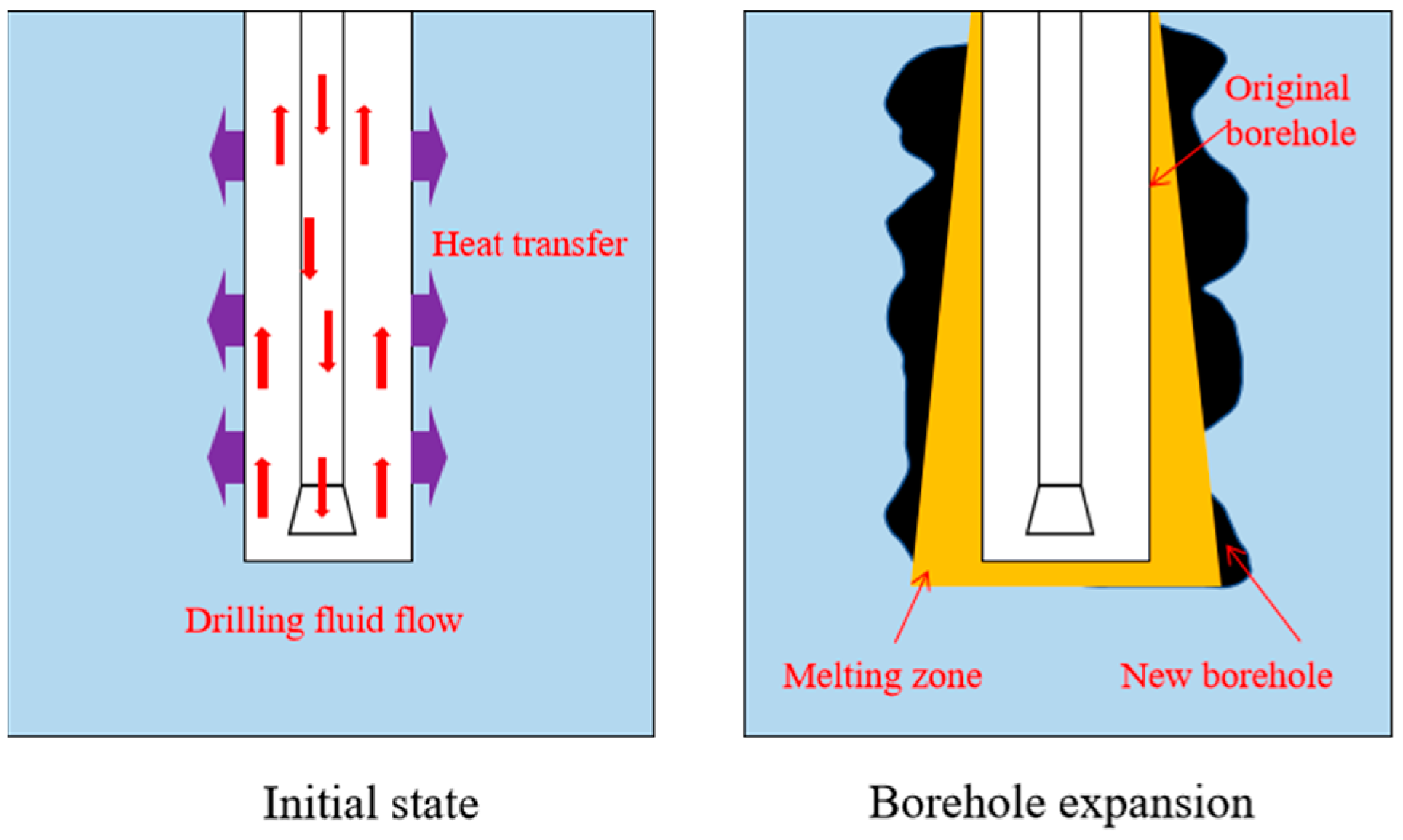
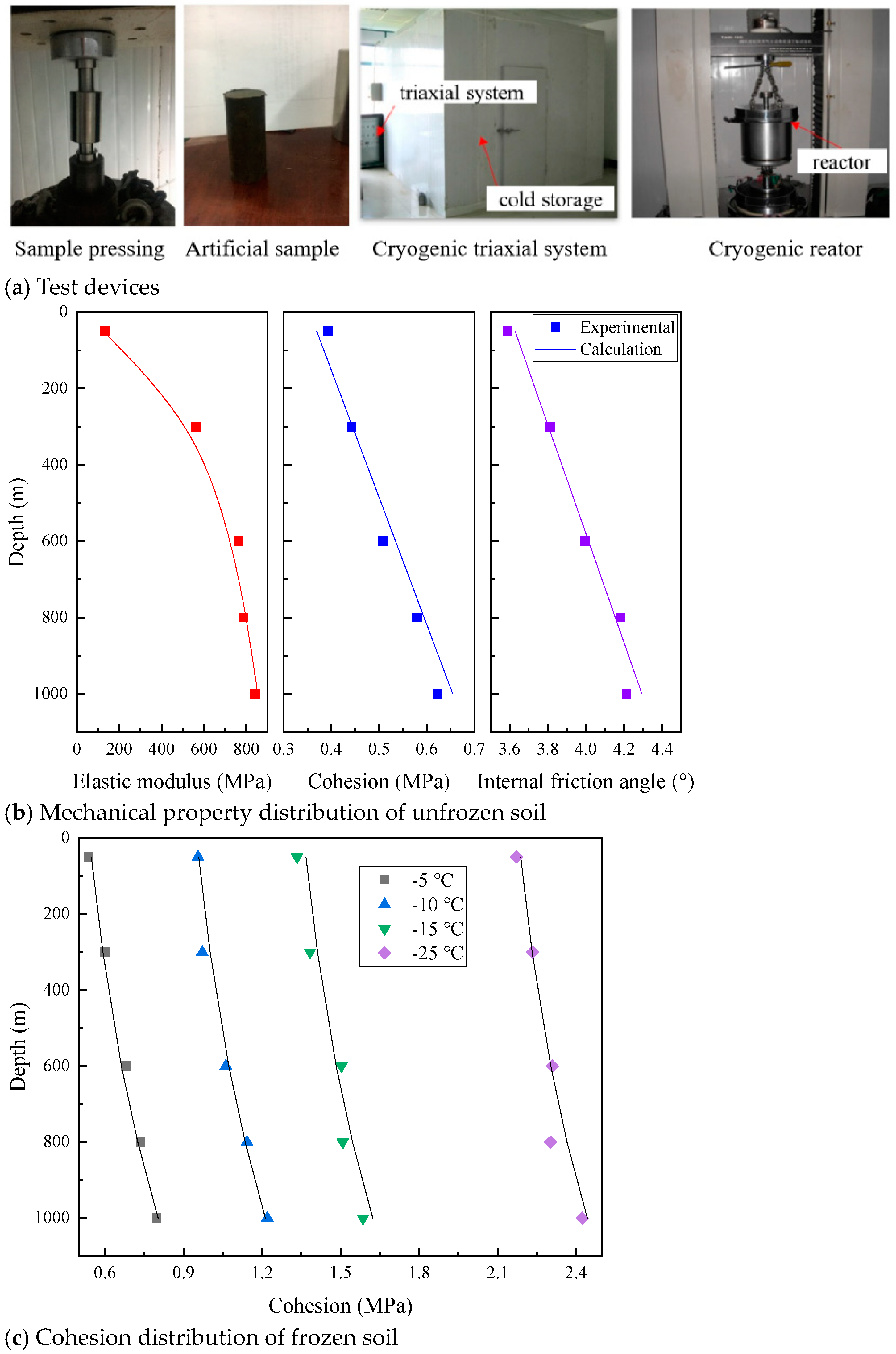
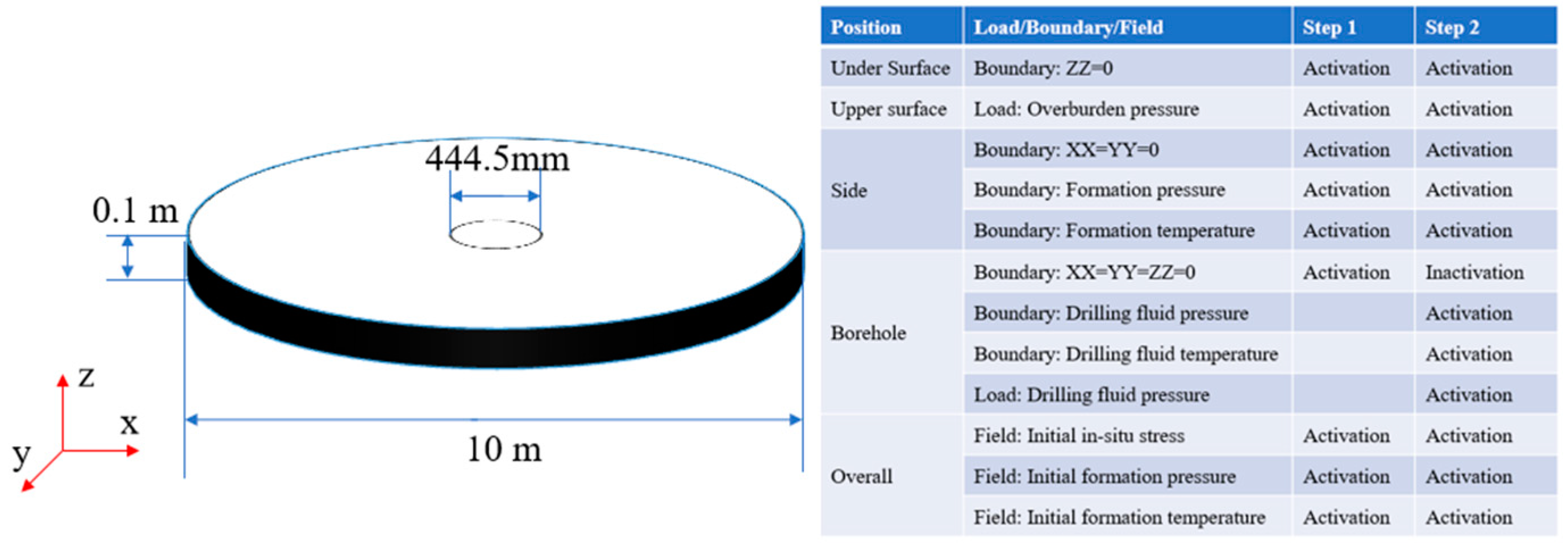
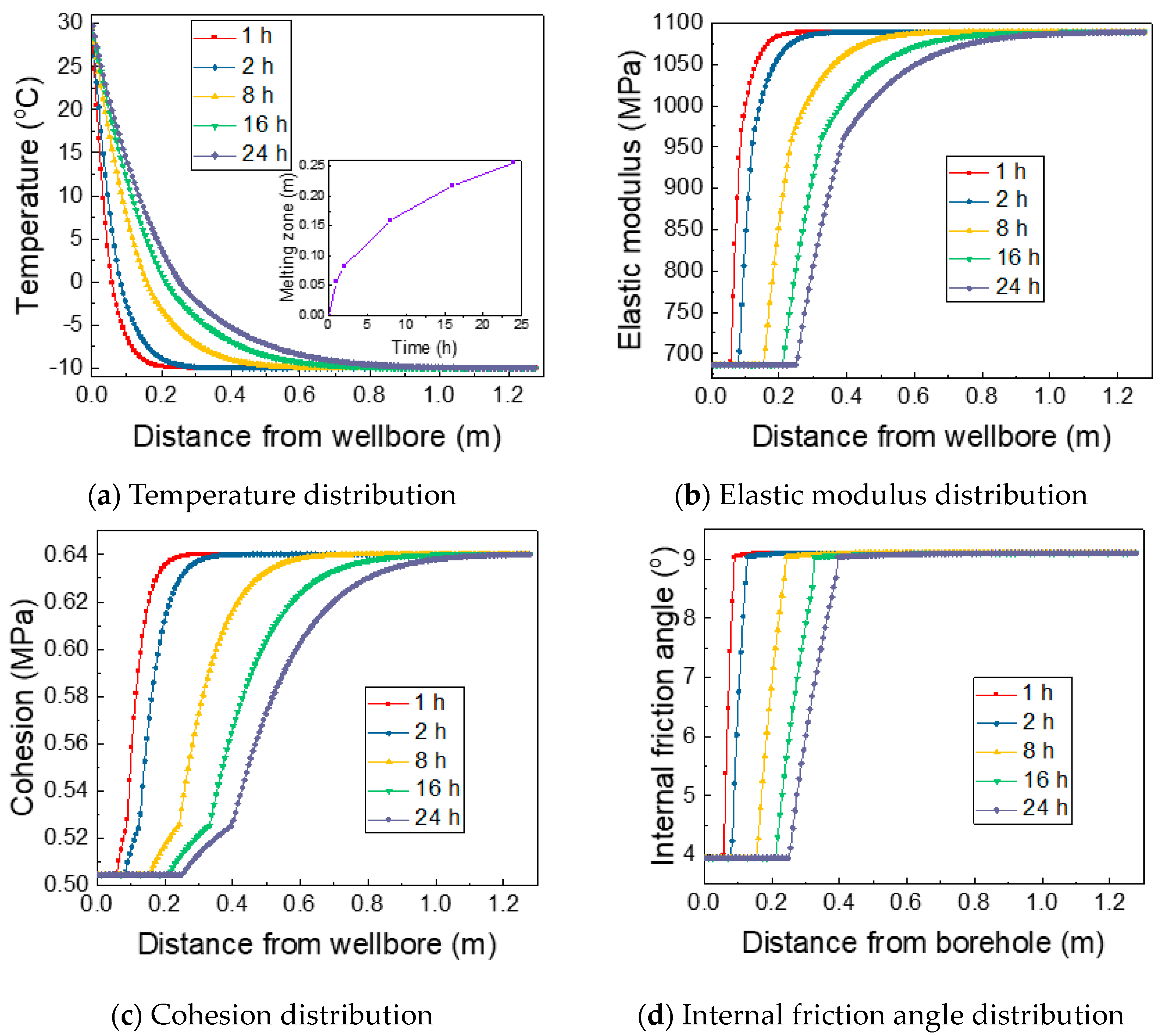
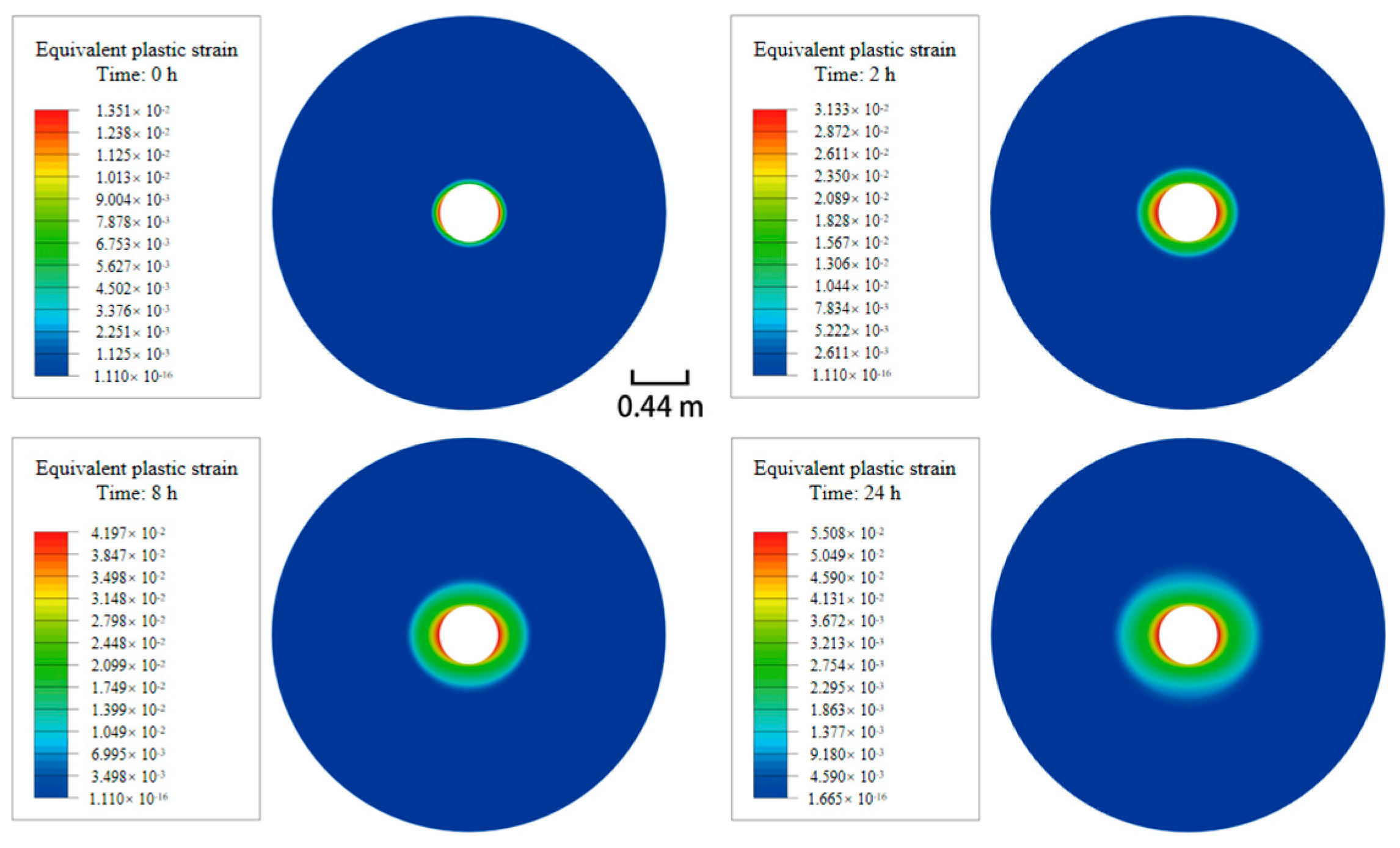

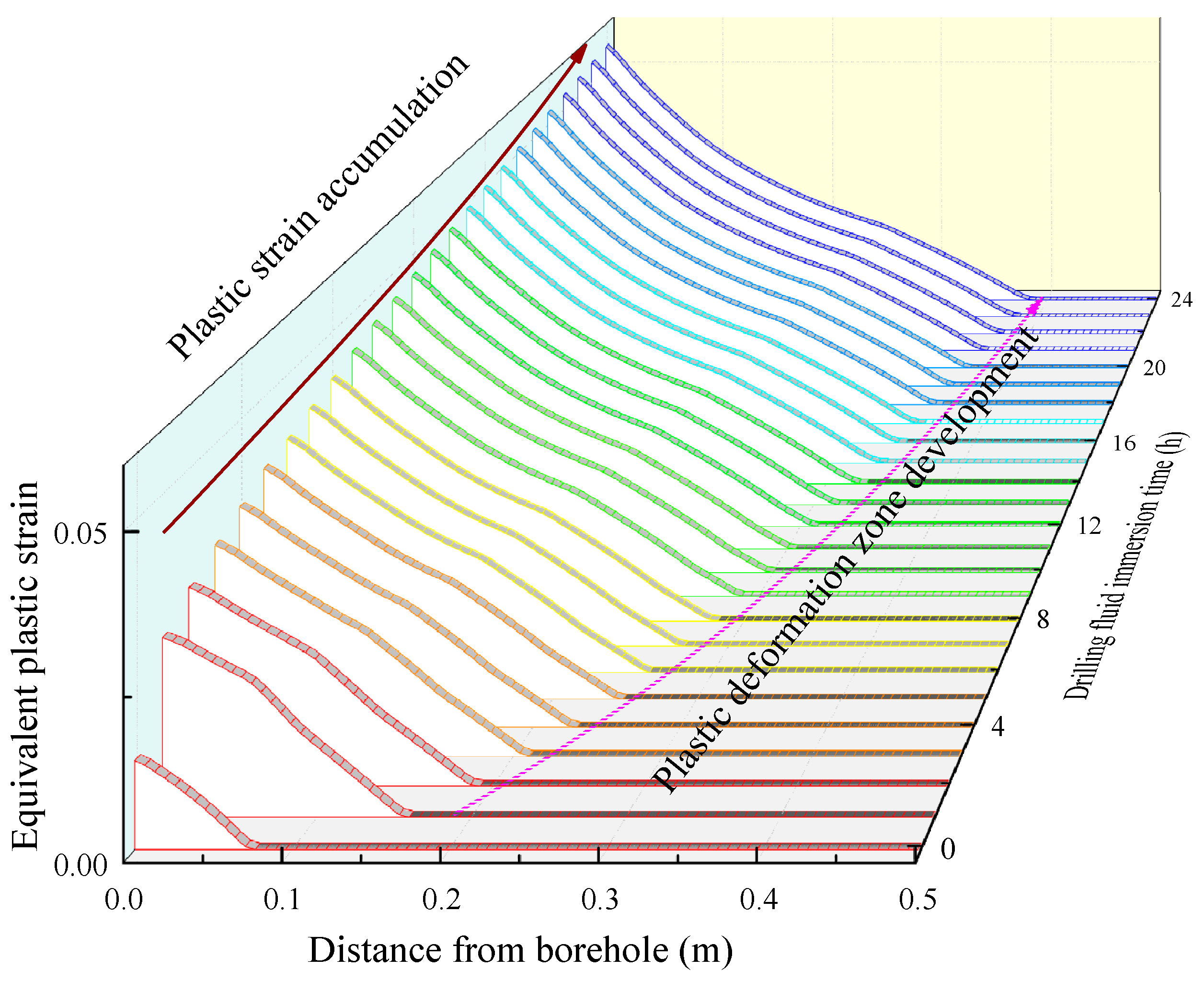

| Parameter | Value |
|---|---|
| Thermal conductivity of soils/W·(m·°C)−1 | 1.383 |
| Thermal conductivity of ice/W·(m·°C)−1 | 2.22 |
| Thermal conductivity of water/W·(m·°C)−1 | 0.55 |
| Specific heat capacity of soils/J·(kg·°C)−1 | 982 |
| Specific heat capacity of ice/J·(kg·°C)−1 | 4200 |
| Specific heat capacity of water/J·(kg·°C)−1 | 1930 |
| Heat transfer coefficient/W·(m2·K)−1 | 750 |
| Phase-change latent heat of ice/J·(mol)−1 | 333,000 |
| Density of dry soils/kg·(m)−3 | 1450 |
| Density of ice and water/kg·(m)−3 | 1000 |
| Coefficient of thermal expansion of soils | 9.67 × 10−6 |
| Coefficient of thermal expansion of ice (T ≤ 0 °C) | −5.1 × 10−5 |
| Coefficient of thermal expansion of water (0 °C < T ≤ 4 °C) | −1.67 × 10−5 |
| Coefficient of thermal expansion of water (T > 4 °C) | 2.93 × 10−5 |
| Permeability of permafrost (darcy) | 1 × 10−14 |
| Permeability of thawed permafrost (darcy) | 1 × 10−8 |
| Poisson’s ratio of soils | 0.35 |
| Drilling Fluid Density (g/cm3) | ||||||||
|---|---|---|---|---|---|---|---|---|
| Depth/Temperature | Critical Plasticity Strain (%) | 1.0 | 1.05 | 1.1 | 1.15 | 1.2 | 1.25 | 1.3 |
| 300 m/−10 °C | 10 | 0% | 0% | 0% | 0% | 0% | 0% | 0% |
| 15 | 0% | 0% | 0% | 0% | 0% | 0% | 0% | |
| 20 | 0% | 0% | 0% | 0% | 0% | 0% | 0% | |
| 400 m/−7 °C | 10 | 0% | 0% | 0% | 0% | 0% | 0% | 0% |
| 15 | 0% | 0% | 0% | 0% | 0% | 0% | 0% | |
| 20 | 0% | 0% | 0% | 0% | 0% | 0% | 0% | |
| 500 m/−4 °C | 10 | 15% | 13% | 11% | 9% | 8% | 6% | 4% |
| 15 | 1% | 0% | 0% | 0% | 0% | 0% | 0% | |
| 20 | 0% | 0% | 0% | 0% | 0% | 0% | 0% | |
| 600 m/−1 °C | 10 | 31% | 27% | 23% | 19% | 17% | 14% | 10% |
| 15 | 19% | 16% | 12% | 9% | 7% | 4% | 2% | |
| 20 | 11% | 9% | 6% | 4% | 1% | 0% | 0% | |
| Drilling Fluid Density (g/cm3) | ||||||||
|---|---|---|---|---|---|---|---|---|
| Depth/Temperature | Critical Plasticity Strain (%) | 1.0 | 1.05 | 1.1 | 1.15 | 1.2 | 1.25 | 1.3 |
| 300 m/−16 °C | 10 | 0% | 0% | 0% | 0% | 0% | 0% | 0% |
| 15 | 0% | 0% | 0% | 0% | 0% | 0% | 0% | |
| 20 | 0% | 0% | 0% | 0% | 0% | 0% | 0% | |
| 400 m/−13 °C | 10 | 0% | 0% | 0% | 0% | 0% | 0% | 0% |
| 15 | 0% | 0% | 0% | 0% | 0% | 0% | 0% | |
| 20 | 0% | 0% | 0% | 0% | 0% | 0% | 0% | |
| 500 m/−10 °C | 10 | 0% | 0% | 0% | 0% | 0% | 0% | 0% |
| 15 | 0% | 0% | 0% | 0% | 0% | 0% | 0% | |
| 20 | 0% | 0% | 0% | 0% | 0% | 0% | 0% | |
| 600 m/−7 °C | 10 | 20% | 14% | 9% | 0% | 0% | 0% | 0% |
| 15 | 0% | 0% | 0% | 0% | 0% | 0% | 0% | |
| 20 | 0% | 0% | 0% | 0% | 0% | 0% | 0% | |
| 700 m/−4 °C | 10 | 20% | 18% | 15% | 13% | 11% | 8% | 6% |
| 15 | 9% | 7% | 5% | 4% | 1% | 0% | 0% | |
| 20 | 3% | 1% | 0% | 0% | 0% | 0% | 0% | |
| 800 m/−1 °C | 10 | 74% | 66% | 60% | 52% | 46% | 40% | 35% |
| 15 | 52% | 46% | 40% | 35% | 30% | 26% | 21% | |
| 20 | 40% | 34% | 29% | 25% | 21% | 17% | 16% | |
Disclaimer/Publisher’s Note: The statements, opinions and data contained in all publications are solely those of the individual author(s) and contributor(s) and not of MDPI and/or the editor(s). MDPI and/or the editor(s) disclaim responsibility for any injury to people or property resulting from any ideas, methods, instructions or products referred to in the content. |
© 2024 by the authors. Licensee MDPI, Basel, Switzerland. This article is an open access article distributed under the terms and conditions of the Creative Commons Attribution (CC BY) license (https://creativecommons.org/licenses/by/4.0/).
Share and Cite
Shi, J.; Li, Y.; Yan, C.; Xue, M. Stability Analysis of Borehole Walls When Drilling with Normal-Temperature Drilling Fluids in Permafrost Strata. Processes 2024, 12, 1819. https://doi.org/10.3390/pr12091819
Shi J, Li Y, Yan C, Xue M. Stability Analysis of Borehole Walls When Drilling with Normal-Temperature Drilling Fluids in Permafrost Strata. Processes. 2024; 12(9):1819. https://doi.org/10.3390/pr12091819
Chicago/Turabian StyleShi, Jihui, Yang Li, Chuanliang Yan, and Mingyu Xue. 2024. "Stability Analysis of Borehole Walls When Drilling with Normal-Temperature Drilling Fluids in Permafrost Strata" Processes 12, no. 9: 1819. https://doi.org/10.3390/pr12091819





